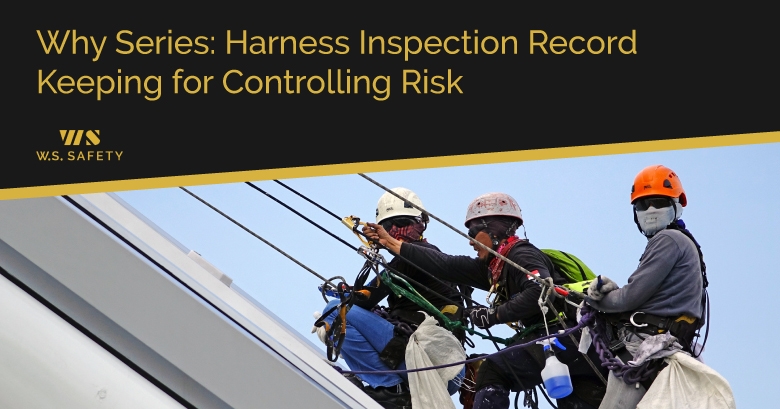Maintaining safety on construction sites requires the implementation of a comprehensive fall protection program. Elements of the program include educating and training workers on the proper use of equipment, the selection of equipment appropriate to the worker and their job, and instruction on how to inspect the equipment.
With falls from heights remaining the leading cause of death and injury in Ontario workplaces, the importance of thorough inspection cannot be overstated.
Unfortunately, many fall-related injuries or casualties are caused by improper use and care of fall protection equipment, or the result of failure to take appropriate fall protection measures. Given the statistics, taking proper safety measures in the workplace is something that many employers and workers have yet to take as seriously as they should.
Harness and lanyard inspection should be a regular practice for workers and completed before every use. Furthermore, the Ontario government requires that all fall arrest equipment be certified at least once a year by a qualified inspector.
Inspecting safety equipment properly requires a thorough understanding of what to look for and what measures to take if the equipment appears faulty or damaged.
It’s also important to understand preventative safety measures, including how to clean and store the equipment appropriately. We have summed up what you need to know about safety harness inspection training below.
FALL PROTECTION HARNESS INSPECTION REQUIREMENTS
OHSA requires all workplaces using fall protection equipment to hold a safety harness inspection certificate.
Employers are required by law to have all safety harness equipment inspected once a year (or more, depending on the situation) by a professional to achieve this certification.
Many companies offer professional training on fall protection equipment inspection, where workers learn about relevant government legislation, manufacturer’s requirements, how to keep records and maintain tracking systems, equipment maintenance and storage, and specific inspection processes for particular pieces of equipment.
So how often should workers check their equipment? OHSA states:
1926.502(d)(21): Personal fall arrest systems shall be inspected prior to each use for wear, damage and other deterioration, and defective components shall be removed from service.
In other words, workers are expected to inspect their equipment daily and record these inspections for OHSA.
Inspections should be conducted before every use of the equipment. They should be thorough, with attention given to the manufacturer’s instructions for proper use and care. This could include any hazard warnings, the maximum distance that a harness can stretch, instructions for appropriate fit, and how to make adjustments to the fit if necessary.
If equipment shows visible signs of damage, it must not be used. All damaged equipment must be reported to the workplace supervisor and be removed from use until a qualified inspector can assess whether or not it can be salvaged.
HARNESS INSPECTION RECORD TEMPLATE
Before inspecting equipment, workers should be fully knowledgeable in the manufacturer’s instructions for proper use, maintenance, and storage.
It is also expected that workers refer to OHSA’s standards for choosing appropriate equipment for the task at hand, and that all equipment is marked with easily legible OHSA/CSA labels. Each element of equipment should be inspected as follows:
WEBBING & SAFETY STRAP – Bending into an upside-down “U” shape, hold the body side toward you and keep your hands approximately six to eight inches apart. Check for:
- UV damage (appears as discoloration)
- any fraying or cuts, or broken webbing fibers (look for tufts)
- any evidence of contact with chemicals or heat damage (burns, holes, soiling or splatters)
D-RINGS – Make sure to check all back pads, hardware, and keepers thoroughly, looking for:
- any damage, including grooves or bent parts
- Cracks or sharp edges
- Corrosion or evidence of heat damage
- Any rotting in the stitching or thread separation
- Stretched or broken loops
BUCKLES – A preliminary check for any damage, corrosion, or loose, elongated or broken grommets should be followed by more thorough inspection, including:
- Distortion of the buckle or any sharp edges (the roller should turn easily and both outer and centre bars should be set straight)
- Any corrosion or cracking in the rivets
- Any springs that stick
ROPES – Ropes often have a shorter lifespan than other pieces of equipment, so regular inspection is especially critical.
The entire rope lanyard should be checked from one end to the other. Weakened areas may appear fuzzy or worn and will have a smaller diameter than the rest of the rope. A rope must be replaced when the diameter across the whole is not uniform.
SNAP HOOKS – Hooks should be examined for:
- Signs of wear and/or grime build-up
- Any sharp edges, grooves or cracks
- A functioning locking action
- Any corrosion or other signs of damage
LANYARDS & LIFELINES – The equipment should bear appropriate OHSA/CSA labelling and should be inspected for:
- Damage including fraying, cuts, or tears
- Knotting
- Dirt and grime build-up and/or evidence of chemical contact
- Discoloration due to UV exposure
- Signs of heat damage including splattering, burns, or holes
- Appropriate spring tension (retraction and retention perform well)
- Any bending or distortion in the housing or broken wires
Safety harnesses must be approved by the Canadian Standards Association (CSA) and bear the label on all ropes and lanyards. It is also important to pay close attention to the manufacturer’s instructions for use and proper care.
In summary, harness inspection is something that should be done every day by every worker, and at least once a year by a trained professional.
Each inspection needs to be recorded carefully with attention to detail. When it comes to fall prevention, keeping thorough records of equipment inspection is of critical importance. Regular inspections are the best way to keep track of wear and tear on your gear and address any problems preemptively – before anyone gets hurt.


